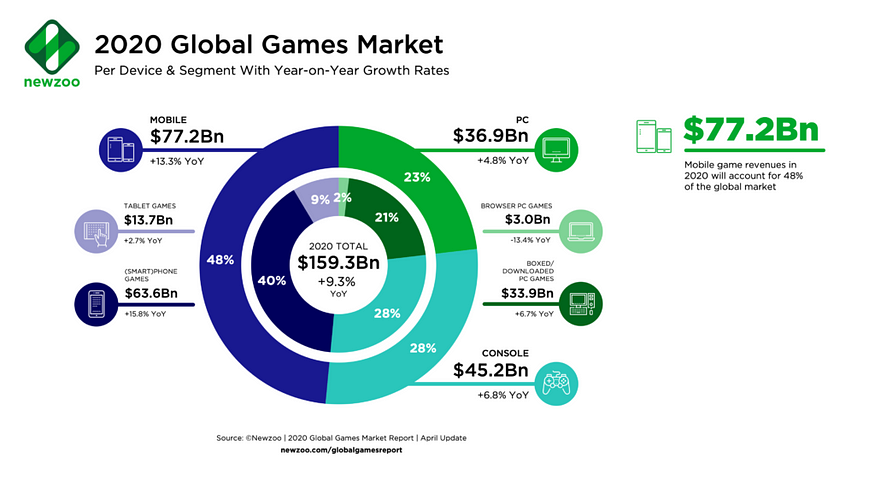To make it more organized, in the first part, I’ll cover some theory and the background story. Secondly, I will explain why I believe mobile games are more dangerous to adults than to kids. Lastly, I’m going to share a few real-life stories and steps those people took to cope with situations they consciously walked into.
The background
First question: what devices can you play video games on? I’m pretty sure you’ve heard about gaming on computers (PC), consoles (PlayStation, Xbox, Nintendo are the most famous right now) and some portable devices (like mobile phones and tablets).

The next question — which of the device(s) above do you think brings the most revenue to the game developers? Your first guess will be either PC or one of the popular consoles, am I right?
Very few people would even take portable gadgets into the equation. If you played a mobile game yourself or have seen your kids doing that on some tablet, you’re quite confident 99.9% of such games are for free. Literally, they come with a $0 price tag — just download and play. And that is correct, they are free to start playing.
Here comes a big surprise: how would you feel if I tell you neither PC nor console games are making the most money in the gaming industry?
For the past decade, video games on mobile devices have shown steady revenue growth. Mobile game developers’ income was growing almost exponentially until these games generated more revenue than PC and console ones.
Below is the 2020 data. If the trend remains, by 2023 mobile games will be making more money than the rest of the platforms altogether.

Is a Free-to-play game really free?
Let’s start with a definition one can find on Wikipedia:
Free-to-play (F2P or FtP) video games, also known as free-to-start, are games that give players access to a significant portion of their content without paying.
Yes, you can download a free-to-play game completely for free. You can start playing, and earn some progress and satisfaction from multiple things you’ve acquired for free at the start. The longer you play — the more options you unlock and feel more rewarded for the time you’ve invested.

But at a certain moment, you start feeling less and less powerful. Your progression will slow down, you will either need to wait for some in-game resources to recover or repeat certain actions so many times that you will be able to do them with your eyes closed. However, the progress will remain too slow and the more advanced items you now wish to get are not even available for you as a free-to-play person.
Luckily, game developers are here to give you a helping hand and keep you progressing further into the new world. For a small fee, of course, but real money this time. Well, it’s just a $1 or $5, what’s the big deal? I’ll explain that later.
Let’s go through the mechanics first.
Depending on the game, there are several types of paid aids utilized. Regardless if they were implemented on their own or combined, the most common are:
- Customised visual style (skin)
Your in-game building, character or vehicle can be altered with a nicer appearance than the default one. Often comes with additional bonuses, that are not available otherwise. Most probably visible to other players directly in the game or easy to share via social networks.
What you pay real $ for: obtaining a skin is possible exclusively via the in-game shop. Helps you looking unique in the playing crowd.
- Resource-oriented (energy bars)
An in-game action requires you to spend a certain amount of resources to proceed further. Can be implemented as a countdown timer (i.e. new action is available after a 15-minute cooldown) or as a resource bar: petrol for your vehicle, the stamina of your character, the morale of your troops and so on.
What you pay real $ for: resetting timers/energy bars to have additional chances of performing the desired action. Meaning your progress quicker than those, who preferred to rely on the default refresh rate.
- Power boosters
Allow an immediate increase in your character’s parameters, your troops’ attack/defence ratings, vehicle’s speed, building’s production etc. Usually obtainable in small quantities by performing daily in-game events or progressing story missions.
What you pay real $ for: getting same boosters from the in-game shop. (un)Intentionally avaiable in limited amounts with a price tag growing exponentially the more you buy.
- Premium currency
The majority of the games come with some internal currency system, used to measure the price of the in-game goods. While the main currency is, normally, earned by playing and progressing the game, it is often accompanied by a superior one. Sometimes even two, but can be more than that. The idea of premium currency is to wipe the effect of buying some in-game goods directly and inject a “middle-man” denoting the value of the real money.
What you pay real $ for: topping up the virtual currency balance. You can spend it immediately or later on literally on any in-game aspect — starting from getting special goods ending with temporary “power” effects.
- Loot boxes
A consumable virtual item that allows you to obtain more in-game items via a randomized selection or “drop”. Can be any existing item or premium items/currency described above. The rarer item is — the lesser chance of getting it dropped from the loot box, forcing the player to try his luck until he gets what he wants. Quite a common approach is offering players a free loot box per day with a limited pool of prizes and a “premium” one with extended rewards.
What you pay real $ for: loot boxes, packs of loot boxes, special events (i.e. Christmas) loot boxes, you-have-achieved-this-stage loot boxes and so on.
- Capsule-toy vending machine (Gacha)
Similar to the loot boxes, gacha mechanics comes from the East, faring particularly well in Japan. You spend some amount of the in-game currency for a chance to pull a special card (can be a character, a booster, an improvement, or any item) in a slot machine/roulette style. The main difference from loot boxes is that you can’t progress further in the game without doing enough gacha pulls. While game developers grant players a certain amount of pulls for free (per day/per week/per event), usually it’s not enough for any meaningful progress.
What you pay real $ for: additional gacha pulls, allowing to progress faster or getting higher rank in the competivive game events.
How come mobile gaming took over?
I believe there was a combination of factors. My short response will be the following: due to accessibility.

On the one side: you don’t need to buy or build a PC. You don’t need a TV for plugging the console into. You don’t need to pay a typical $60 price tag for a new game. And you already own a mobile phone anyway.
On the other side: your mobile phone is always with you. You can play while commuting, over lunch or when kids fall asleep. It is powerful enough to run a decent-looking game. It doesn’t consume space on your desk or occupy a TV in your living room. And, once again, you don’t have to pay for a game to start playing.
Last, but not least, your game catalogue, progress and preferences are connected to one single account (either iOS or Android). You don’t need to think if the game is compatible with PC, Xbox or PlayStation — you just download what you like from the Store. You don’t need to worry if you lost or changed your phone: once you signed in on your new device, all your library will be available again. You don’t care about specific payment methods either — as soon as you have your credit card connected to the Store, there’s no need to go outside.
While I was not able to find a reliable source for the number of games available per mobile platform, Steam (the most popular PC gaming platform) has reached “only” 30.000 games. If we take the Google store as an example, out of 3 million apps there, over 430.000 are games!
But it’s not about the number. It is about the time spent playing on the phone. The most recent I could find was from April when COVID was not even considered a big threat.

So a lot of people suddenly found themselves locked at home for an extended period of time. While it caused tremendous growth in the video-streaming services (Netflix, YouTube and similar), we’ve also started to play more than before.

A ticking bomb in your hands
Have you noticed how some of the most interesting aspects of human nature got amplified by the current COVID situation? Let’s try to put a puzzle together, where it’s related to gaming.

- A sudden increase in your spare time. Since you don’t travel, commute less or not at all, and meet your close ones (friends or relatives) on fewer occasions, there’s a void you need to fill in. What have you got left to do, if you’ve watched all available episodes of your favourite TV show, read a book, exercised, taken care of the house routine, you name it? Play!
- If you never played before and are not really into the topic, I assume you think a computer is for work and a console is for kids. You won’t probably buy one for yourself, because, well, you’re an adult. After the next iteration of boredom, you’ve decided to install a game on your phone. Well, it’s free anyway, why don’t give it a try?
- Provided your income has not changed, an abundance of money in your account might be not so easy to deal with. I’m not speaking about millions here. Just a spare $100 or $200. Or $500. Add here the fact of how easy is to buy something on your phone — just scan your fingerprint and the purchase is completed!
- Do you like shopping? While purchasing real goods has a limit (mostly limited by the physical dimensions of the place you live in), spending on non-existing virtual goods doesn’t have any.
- A new routine. The majority of games come with a set of daily tasks, completing which will earn you extra rewards. It creates a habit. First, you don’t even notice it, then you’re afraid to miss a day cause it might end your weekly/monthly streak and result in a bigger reward being lost.
- Virtual friends. Since you don’t hang out with your co-workers, friends, relatives or anyone close to you, at a certain point you find a community of people playing the same game. They understand you really well — mostly, grown-ups, with a job and family, looking for some entertainment, safe and easy to start. You talk via the in-game chat, you meet on a daily basis to complete (in-game) events you have in common. Now, you don’t want to fall behind and if they spend in the game — you’ll spend as well.
Soon I will publish my next article describing how game developers make use of certain human weaknesses and benefit from the current lockdown.

Leave a Reply